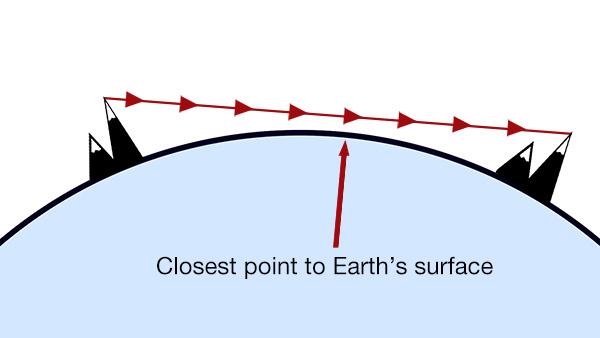As defined in Wikipedia, refraction is:
The change in direction of a wave due to a change in its transmission medium.
In our case, the wave changing direction is the visible light, and the transmission medium is atmospheric air.
Air temperature varies along the height, decreasing from surface to tropopause, approximately at 11.000 meters above sea level.
This temperature change modifies air properties, specifically it changes density and so it changes its refractive index.
When looking at a distant mountain, the line of sight is not always at the same height above sea level, as shown in this figure:

This variation causes the travelling light to cross air at different conditions, curving its trajectory as a consequence of changing refractive index.
And then allowing hidden mountain to show up above the horizon.

This light curving effect of refraction can be clearly seen in this picture of the rising sun, with a deformed shape as a consequence:

Sunrise as seen from Vistabella del Maestrazgo (1.246 meters)
For more information:
Pingback: Bieszczady – Pietrosul Rodnei | 216 km. | Beyond Horizons
So you guys actually think you are taking pictures of mirages?? Or do you just have to put the geometry and refraction material so it makes sense why you can actually do what you do?
LikeLiked by 1 person
Also the sun isn’t a solid object like a mountain? How can you clearly see refraction on the sun when it’s a big ball of radiation? It would always have a deformed shape, no?
LikeLike
The sun is sold disc shape as seen from earth. Any photo of the sun with a solar filter will show that.
U only get that horizontal ripple/compression effect when its on thr horizon.
LikeLike
Both those images showing how we see another mountain from the top of another mountain are wrong, and if you can’t see it you’re not using any critical thinking. All human beings stand vertical (FACT) and look out at a 90 degree angle across horizontally at the horizon (FACT). We DON’T look across at the strange angle (looks like 125 degrees) that is portrayed in those two images. That wikipedia article on refraction is more brainwashing against what we do, and see in reality with our eyes.
LikeLiked by 1 person
@Jim Slim
Good point it’s not 125, but let me explain how I would excuse the author;)
It’s obviously exaggerated all in the picture, however I suppose it was only meant to illustrate the fact that when looking at very distant object the angle may become non-negligible. For example the angle between objects 200 km away from each other is 200 / 40000 * 360 = 2 degrees. Right, that’s just 2 degrees, but those 2 degrees, this little curve of earth is crucial. If 92 was illustrated instead of 125 nobody would notice that!
LikeLiked by 2 people
How come the mountains aren’t bent away on the photo as they should be regarding your illustration? To dumb to see the obvious? you must unlearn what you have been indoctrinated with!! Good luck and GOd bless!!
LikeLike
Actually no. The horizon is fractionally below 90 degrees when we view from low level (2+ meters). Easliy measurble with a theodolite.
That horizon drop below 90 increases as the viewer rises up.
Although the images on this page are a bit over exaggerated – mostly because of scale.
LikeLike
Tell us:
1) by what degree u would expect the mountains to bend away? (Very simple math)
2) how u would measure or observe that result of an irregular/undefined shaped mountain which annoyingly tend to taper up at the top.
LikeLike
Very simple way to disprove Flat Earth (of course, Flat Earthers do not seem to have the reasoning skills to recognize this, but here it is for everyone else)… the image of Pic Gaspard (3880m) and Grand Ferrand (2758m) from Pic de Finestrelles (2826m) in the Pyrénées.
You can clearly see that Gaspard is the taller mountain BUT still,. Ferrand appears higher above the horizon. This is NOT accounted for by perspective. You can see in the side-by-side analysis done here where we render the two mountains on both an Earth curvature surface with refraction and a Flat Plane that on the Flat Plane this would NOT happen — Gaspard should still stand taller if the Earth was flat — the correct view is only obtained on the Globe model.
Here is the full analysis — including showing how tall the mountains would appear in the photograph if you could actually see the entire mountain (which you don’t).
https://flatearthinsanity.blogspot.com/2017/11/pic-gaspard-3880mgrand-ferrand-2758m.html
LikeLike
Tell us:
1) by what degree u would expect the mountains to bend away? (Very simple math)
2) how u would measure or observe that result of an irregular/undefined shaped mountain which annoyingly tend to taper up at the top.
LikeLike